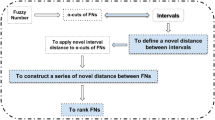Abstract
Fuzzy logic is one of the effective tools to handle uncertainty and vagueness in engineering and mathematics. One major part of fuzzy logic is ranking fuzzy numbers. In many fuzzy program systems, ranking fuzzy numbers has a remarkable role in decision making and data analysis. Despite the fact that a variety of methods exists for ranking fuzzy numbers, no one can rank fuzzy numbers perfectly in all cases and situations. In this paper, a new method for ranking fuzzy numbers based on the left and right using distance method and α-cut has been presented. To achieve this, a fuzzy distance measure between two generalized fuzzy numbers is proposed. The new measure is expanded with the help of the fuzzy ambiguity measure. The calculation of this method is derived from generalized trapezoidal fuzzy numbers and distance method concepts. Furthermore, a comparison of generalized fuzzy numbers between the proposed method and other resembled methods is provided.

Similar content being viewed by others
References
Abbasbandy S, Asady B (2006) Ranking of fuzzy numbers by sign distance. Inf Sci 176:2405–2416
Abbasbandy S, Hajjari T (2009) A new approach for ranking of trapezoidal fuzzy numbers. Comput Math Appl 57(3):413–419
Asady B, Zendehnam A (2007) Ranking fuzzy numbers by distance minimization. Appl Mathemat Model 31(11):2589–2598
Adamo JM (1980) Fuzzy decision trees. Fuzzy Sets Syst 4:207–219
Baas SM, Kwakernaak H (1977) Rating and ranking of multiple-aspect alternatives using fuzzy sets. Automatica 13:47–58
Baldwin JF, Guild NCF (1979) Comparison of fuzzy sets on the same decision space. Fuzzy Sets Syst 2:213–233
Chang WK (1981) Ranking of fuzzy utilities with triangular membership functions. In: International conference on policy analysis and informations systems, Tamkang University, ROC, pp 163–171
Dubois D, Prade H (1983) Ranking fuzzy numbers in the setting of possibility theory. Inf Sci 30:183–224
Fortemps P, Roubens M (1996) Ranking and defuzzification methods based on area compensation. Fuzzy Sets Syst 82:319–330
Jain R (1977) A procedure for multiple-aspect decision making using fuzzy set. Int J Syst Sci 8:1–7
Jain R (1976) Decision-making in the presence of fuzzy variable. IEEE Trans Syst Man Cybern 6:698–703
Kim K, Park KS (1990) Ranking fuzzy numbers with index of optimism. Fuzzy Sets Syst 35:143–150
Liou T, Wang J (1992) Ranking fuzzy numbers with integral value. Fuzzy Sets Syst 50:247–255
Wang X, Kerre EE (2001) Reasonable properties for the ordering of fuzzy quantities (I). Fuzzy Sets Syst 118:375–385
Yager RR (1981) A procedure for ordering fuzzy subsets of the unit interval. Inf Sci 24:143–161
Yao J, Wu K (2000) Ranking fuzzy numbers based on decomposition principle and signed distance. Fuzzy Sets Syst 116:275–288
Kandel A (1986) Fuzzy mathematical techniques with applications. Addison-Wesley, Reading, MA
Bass S, Kwakernaak H (1977) Rating and ranking of multiple-aspect alternatives using fuzzy sets. Automatica 13:47–58
Dubios D, Prade H (1978) Operations on fuzzy numbers. Int J Syst Sci 9:613–626
Baldwin JF, Guild NCF (1979) Comparison of fuzzy numbers on the same decision space. Fuzzy Sets Syst 2:213–233
Adamo M (1980) Fuzzy decision trees. Fuzzy Sets Syst 4:207–219
Yager RR (1980) On choosing between fuzzy subsets. Kybernetes 9:151–154
Yager RR (1981) A procedure for ordering fuzzy subsets of the unit interval. Inf Sci 24:143–161
Bortolan G, Degani R (1985) A review of some methods for ranking fuzzy numbers. Fuzzy Sets Syst 15:1–19
Chen SJ, Hwang CL (1992) Fuzzy multiple attribute decision making. Spinger, Berlin
Chu T, Tsao C (2002) Ranking fuzzy numbers with an area between the centroid point and original point. Comput Math Appl 43:111–117
Chakraborty C, Chakraborty D (2006) A theoretical development on fuzzy distance measure for fuzzy numbers. Math Comput Model 43:254–261
Guha D, Chakraborty D (2010) A new approach to fuzzy distance measure and similarity measure between two generalized fuzzy numbers. Appl Soft Comput 10:90–99
Sepehriar A, Eslamipoor R, Nobari A (2013) A new mixed fuzzy-LP method for selecting the best supplier using fuzzy group decision making, neural computing and applications. doi:10.1007/s00521-013-1458-z
Eslamipoor R, Janizade Haji M, Sepehriar A (2013) Proposing a revised method for ranking fuzzy numbers. J Intell Fuzzy Syst 25:373–378
Zimmermann HJ (1991) Fuzzy set theory and its applications. Kluwer Academic, Norwell, MA
Kaufmann A, Gupta MM (1985) Introduction to fuzzy arithmetic: theory and applications. Van Nostrand, New York
Eslamipoor R, Sepehriar A (2013) Firm Relocation as a potential solution for environment improvement using a SWOT-AHP hybrid method. Process Saf Environ Prot. doi:10.1016/j.psep.2013.02.003
Author information
Authors and Affiliations
Corresponding author
Rights and permissions
About this article
Cite this article
Janizade-Haji, M., Zare, H.K., Eslamipoor, R. et al. A developed distance method for ranking generalized fuzzy numbers. Neural Comput & Applic 25, 727–731 (2014). https://doi.org/10.1007/s00521-013-1541-5
Received:
Accepted:
Published:
Issue Date:
DOI: https://doi.org/10.1007/s00521-013-1541-5




